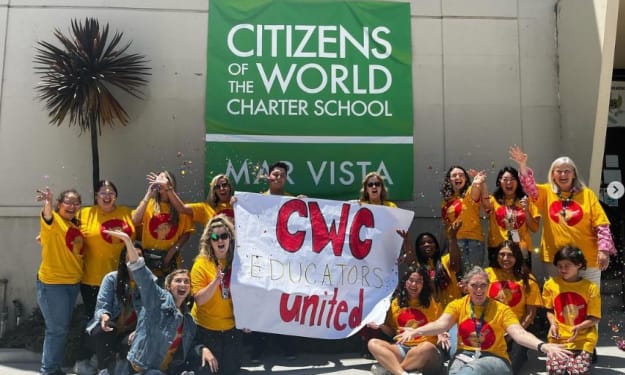Advancing Diversity Even With Texas's DEI Ban
Creating a healthy environment where all people are welcome and safe

In early 2024, Texas’s DEI ban went into effect, and many individuals, organizations, and institutions didn’t know how to react. Personally, I found this news to be anxiety-inducing—laws are intimidating, and seeking to understand their nuances is even more so! But as citizens, it is crucial that we refuse to bow down to fear-mongering, instead remaining informed about the legislation passed in our country. So let’s take the first step together!
In this blog, I will offer a basic breakdown of what, exactly, Texas’s DEI ban articulates, who it impacts, and what actions we can still take that uplift the spirit of DEI—challenging conformity and maintaining a culture of kindness, ideals few if any people in the world resist—while still respecting the law. To be clear, I am not advising any “shortcuts” or “sneaky” means of circumventing the law here; rather, I want to focus on creating a healthy environment where all people are welcome and safe to be themselves—something no law seeks to forbid.
The Law
Let’s start with a step-by-step walkthrough of Texas’s DEI ban, the verbatim text of which can be found here and is the source I will be quoting from. First and foremost, some important clarification: as of March 2024, this DEI ban only applies to state universities in Texas, e.g. the UT system. This ban does not affect private universities, corporations and the workplace, and K-12 education.
Given that my focus is corporate consulting and workplace inclusion, it’s fair to be confused on why I would want to discuss a university-related topic. The answer is simple: these legal challenges to DEI may one day arise in the workplace, and thus there are steps organizations can take or note down now—at the inspiration of higher education—to brace themselves for these challenges. So, let’s walk through this Texan law!
“The governing board of an institution of higher education shall ensure that each unit of the institution: does not, except as required by federal law…”
1) “establish or maintain a diversity, equity, and inclusion office”
This section is fairly self explanatory! State universities are not allowed to have a DEI office anymore.
2) “hire or assign an employee of the institution or contract with a third party to perform the duties of a diversity, equity, and inclusion office”
Relatedly, state universities cannot assign an individual employee or hire a third party to fulfill the job and responsibilities of a DEI office.
3) “compel, require, induce, or solicit any person to provide a [DEI] statement or give preferential consideration to any person based on the provision of a [DEI] statement”
More in the vein of hiring, state universities cannot request individuals to submit statements related to DEI in various applications (e.g. for grants, to be hired, etc.).
4) “give preference on the basis of race, sex, color, ethnicity, or national origin to an applicant for employment, an employee, or a participant in any function of the institution”
Fortunately, DEI programs were already not affording preference to applicants or employees in such a manner, so this clause is easy for state universities to abide by (it’s not difficult to comply with an order that wasn’t being broken in the first place!). After all, the aim of any robust DEI program is to remove barriers that remove preference for or against any groups.
5) “require as a condition of enrolling at the institution or performing any institution function any person to participate in [DEI] training,” which includes any training designed or implemented in reference to “race, color, ethnicity, gender identity, or sexual orientation” but does not include training “developed by an attorney and approved in writing by the institution’s general counsel and the Texas Higher Education Coordinating Board for the sole purpose of ensuring compliance with any applicable court order or state or federal law”
In other words, mandatory DEI training is not permitted at state universities. However, training that has gone through the above specified process and that is related to complying with a relevant court order, state law, or federal law does not fall under the purview of this DEI ban; for example, a federally mandated anti-discrimination training would remain mandatory.
6) “Nothing in this section may be construed to limit or prohibit an institution of higher education or an employee of an institution of higher education from, for purposes of applying for a grant or complying with the terms of accreditation by an accrediting agency, submitting to the grantor or accrediting agency a statement that… highlights the institution’s work in supporting: first-generation college students; low-income students; or underserved student populations; or certifies compliance with state and federal antidiscrimination laws.”
This section clarifies that discrimination remains illegal, and also that universities are allowed to support and demonstrate their work in supporting “first-generation college students; low-income students; or underserved student populations.” So while much of Texas’s DEI ban focuses on race, “color,” ethnicity, gender, and sexual orientation, this ban does not eliminate all forms of support for individuals of those communities. First-gen college students, low-income students, and “underserved student populations” are extremely capacious categories that include students of color, queer students, women, and international students! This DEI ban thus does not stipulate that these groups of students can no longer receive any forms of support.
7) Notably, these restrictions on DEI do not apply to academic course instruction; “scholarly research or a creative work” by a university’s “students, faculty, or other research personnel or the dissemination of that research or work”; recognized student organizations; “guest speakers or performers on short-term engagements”; “a policy, practice, procedure, program, or activity to enhance student academic achievement or postgraduate outcomes that is designed and implemented without regard to race, sex, color, or ethnicity”; data collection; or student recruitment or admissions.
In other words, the DEI restrictions in this ban focus primarily on staff, not academic faculty and students, as well as on long-term DEI-centric initiatives, not a guest speaker coming to discuss the history of race in the United States. To attempt to restrict the activities of faculty, students, and guest speakers might be a violation of free speech, hence why it would not fall under the purview of this DEI ban.
So, we’ve walked through some of the key points of this DEI ban—but what does it mean on a practical level, and what can organizations take away from it? I should first mention that many universities are anxious about this law because its wording is vague, leading many state higher education institutions to overcompensate in terms of how they are “abiding” by this law. Because they don’t know what’s right and what’s wrong, many universities are shutting everything down in an attempt to protect themselves. As of May 2024, more than 300 positions have been eliminated and more than 600 contracts have been terminated, a reality that has disproportionately impacted the employment of women and people of color. So what next?
1) Legal Counsel
I cannot overstate the importance of universities—and in turn, corporations—engaging their legal counsel with regard to new or burgeoning DEI restrictions. Institutions must ensure a) their counsel is up to date with all new legislation or changes in existing law; b) their legal counsel are not just aware but also on board with decisions they make in response to DEI-related law; and c) their legal counsel formally writes off on said decisions and remains in constant conversation with them. In this blog, I’m attempting to provide a basic overview on this DEI ban and what appropriate responses may be, but my summaries should not be mistaken for formal legal advice; they’re simply meant to be stepping stones as we all seek to come to a fuller understanding of the impacts of this law.
2) “Rebrand”
Because Texas has outlawed “DEI offices” in state higher education, logic follows that no matter what happens in the long term, current DEI offices and positions will have to be reevaluated in the present, and that reevaluation includes their names (especially because many universities don’t wish to fire dozens of hardworking employees in one fell swoop). For example, the Chief Diversity Officer may become the Employee Engagement Officer, or the Center for Diversity, Equity, and Inclusion may become the Center for Belonging and Engagement.
To be clear: “rebranding” in this respect does not mean slapping a new label on existing DEI programs and calling it a day! After all, we still must comply with the law, and simply renaming these programs has been declared “unacceptable” by Texas lawmakers. With the advice of legal counsel, universities and corporations can evaluate existing duties associated with the DEI programs and determine what has to go, what can be modified, and what can remain. One university, for example, identified that in order to comply with the law, they can no longer “require… diversity statements in the hiring process.” They also observed, however, that “‘[e]xpanding pipelines to… high schools, expanding student support, getting high school kids committed earlier on to college” are all crucial programs that maintain the spirit of belonging and creativity DEI uplifts and abide by the new law in Texas.
Companies, in turn, can note these types of responses if it ever happens that their own purview over DEI is upended! As such, they might implement name changes, evaluate existing programs in accordance with any new law, and ultimately keep what works while changing what doesn’t (as opposed to shutting down everything in one fell swoop).
3) Discourage Conformity & Welcome Everyone
I’ve referred to “the spirit of DEI” a few times in this blog, so I want to talk about this concept a bit more thoroughly. There are infinite critiques that can be made of DEI bans, many of which involve the reality that most DEI bans involve little to understanding of what DEI actually entails in the first place. At its core, DEI is about being kind to one another, making a welcome space for all people, and encouraging multitudinous ways of thinking to foster innovation and creativity; these goals are not ones that legislation seeks to eradicate. As such, even if the term “DEI” has been forbidden, taking actions that encourage kindness, belonging, and different ways of thinking remain not just acceptable but ought to be encouraged by any government that seeks to support its communities. So, what actions am I talking about?
Challenging conformity in all of its many forms, for one, is crucial. This strategy may manifest in offering all team members and employees equal opportunity to share their ideas in meetings, or it may manifest in appointing someone to be the “critic” for a project who offers a designated critical opinion. Challenging conformity can even be as simple as encouraging ourselves and others to ask Why?
On a broader institutional level, ensuring we maintain practices that uplift the spirit of DEI without violating the letter or spirit of any DEI ban means increasing access to things like affinity groups and employee resources groups (ERGs). Many organizations make such groups open to all individuals from the get-go, but it’s nonetheless worth emphasizing that these types of groups should be open to everyone to join, not just the individuals they are geared toward supporting! For example, an affinity group for veterans should also be open to membership for allies who have not served; similarly, an affinity group for LGBTQ+ individuals should also be open to allies of this community, not just queer people.
Another strategy both universities and corporations can invest in is hosting guest speakers, who are again a specified exception to Texas’s DEI ban. Even if DEI training and long-term projects are forbidden, bringing in a guest speaker to talk about the value of multicultural teams or cognitive diversity are great opportunities to uplift a culture of kindness and belonging.
4) Focus on the Environment
When we think of DEI programs, we often get lost in bureaucracy, which perhaps Texas’s DEI ban is a perfect example of. But the spirit of DEI also means accessibility—a focus on making the physical environment around us (be it a university or a company) as welcoming as possible to all people. How might this manifest?
How about the repair of sidewalks to ensure they’re friendly for wheelchairs and other mobility aids, such as crutches? How about establishing lactation and nursing rooms for nursing parents? How about implementing all-gender bathrooms, not just for trans and nonbinary people but for people with disabilities who need more space to navigate or who have severe claustrophobia? How about crosswalk intersections with both visual and audio components? Nowhere does Texas’s DEI ban state that universities should stop focusing on making their campuses accessible, because such an order would not only be ludicrous but would be a major negative for the reputation of a university. I mean, I can’t imagine it going over well if a university had to turn down a student because they couldn’t accommodate their disability! As such, focusing on the physical environment is a great approach to abide by a new law while still emphasizing one of DEI’s core values: accessibility.
5) Hiring Checklist
The Texas DEI ban defines one of the responsibilities of a DEI office as a division “established for the purpose of… influencing hiring or employment practices at the institution with respect to race, sex, color, or ethnicity, other than through the use of color-blind and sex-neutral hiring processes in accordance with any applicable state and federal antidiscrimination laws.” (Again, this ban only applies to state higher education, not companies.) In other words, the Texas government is evidently concerned about alleged “negative” impacts of DEI on hiring. So, how can universities and (theoretically) corporations respond to this type of challenge?
For one, it should be noted that the point of diverse hiring is “hiring based on merit with special care taken to ensure procedures are free from biases related to a candidate’s age, race, gender, religion, sexual orientation, and other personal characteristics that are unrelated to their job performance,” meaning this DEI ban is arguably professing nonexistent anxieties. Nonetheless, organizations can take the initiative to develop a hiring checklist that focuses on attracting unique, qualified candidates who will bring innovative ideas to their institution without burdening themselves with stress of potentially illegal DEI-related language! Allow me to suggest a few ideas for this checklist:
Job Description:
- Did we use gender neutral language?
- Did we include the appropriate number of years of experience required for the role?
- Are the skills listed aligned with the tasks required?
- Are the skills required or can they be acquired?
- Did we evaluate the education requirement?
- Are the qualities/abilities both listed and reasonable?
- Did we include enough information about the culture of the organization in the job posting?
Advertising the Job:
- Did we allow enough time to find candidates from a multitude of backgrounds?
- Did we include salary ranges based on internal and external data?
- Did we include language to encourage applicants covered under the ADA?
Hiring Committee
- Does the hiring committee consist of people from multiple backgrounds and differing years/types of experience?
- Did we train the staff on conducting unbiased interviews?
- Did we develop the evaluation criteria for the role?
- Did we offer the candidate options for interview schedule modality?
- Did we create an interview question template for consistency?
- Are the required exercises (presentation, case study) appropriate for the role, and are there options given for the delivery?
Hiring Process
- Did we remove/mask the name, location, education/colleges, associations, and pictures from the candidate information prior to the interviews?
- For corporations: Did we have at least 20% diversity in our candidate pool? (Known as the Mansfield Rule, this practice does not, according to business consultant Lily Zheng, violate any laws regarding the illegality of quotas for corporations, because this policy is not a quota—no unfair benefits are allotted to any candidate in the pool. Also, remember that “diversity” goes beyond race and gender! It includes disability, veteran status, sexual orientation, religion, experience, and more.)
- Did we ask each candidate the same questions in the same order?
- Did we refrain from asking multi-part questions?
- Did we give the candidate enough time to answer questions?
- Did we check that the interview questions would not result in bias against the candidate?
- Did we ensure all candidates were interviewed in the same environment (in person vs. Zoom vs. the same conference room)?
Candidate Evaluation
- Did we screen the candidates in vs. screening them out?
- Did we evaluate the candidates based on the essential functions - skills, education, and job requirements?
- Did we ensure all qualifications (non-negotiables) apply to all candidates?
- Did we review the evaluation form for any biases? Such as halo/horn effects, affinity bias, and name bias.
- Did we use the same evaluation criteria that was agreed upon prior to the interviews and rank all candidates accordingly?
- Did we evaluate each candidate based on their cultural or skill adds and on bringing in the talent that we are missing on the team? (“Cultural” here does not refer to a specific heritage but rather the culture of one’s workplace, i.e. were candidates evaluated in accordance with their ability to mesh with and thrive in the organizational work culture.)
- Did we listen to and consider input from all interviewers on the panel?
Not a bad starting point!
6) Non-Discrimination Clause in DEI Policy
To conclude with a brief note specifically related to companies, not universities, it should be noted that one of the best ways to precipitate and prevent legal challenges to one’s DEI programs is the inclusion of a thorough non-discrimination clause in one’s DEI policy. Why? Well, because the “primary basis for claims made by individuals and groups challenging DEI programs is that those programs discriminate against employees on one or more of these protected bases.” As such, incorporating a non-discrimination clause into the core of one’s DEI initiatives helps prevent misinterpretation, both personal and legal, of one’s program—a win-win!
Now, as I reach the end of this blog, I want to reiterate the importance of consulting legal counsel before any institution, be they a university or a corporation or a nonprofit, makes changes under new DEI restrictions. These are untested waters, and thus we should proceed with caution, but to proceed with caution does not mean rejecting the foundational principles of DEI: kindness, accessibility, belonging, and innovation.
I know many of us are frightened, I know many of us are scared, but we will brave this storm together. Onwards and upwards!
____________________________________________________
Dima Ghawi is the founder of a global talent development company with a primary mission for advancing individuals in leadership. Through keynote speeches, training programs and executive coaching, Dima has empowered thousands of professionals across the globe to expand their leadership potential. In addition, she provides guidance to business executives to develop diversity, equity, and inclusion strategies and to implement a multi-year plan for advancing quality leaders from within the organization. Reach her at DimaGhawi.com and BreakingVases.com.
About the Creator
Dima Ghawi
Dima is an award-winning author and a three-time TEDx Speaker. Through keynote speeches, workshops, training programs, and executive coaching, she has honed a keen expertise in developing leaders to meet the demands of the global workforce.
Enjoyed the story? Support the Creator.
Subscribe for free to receive all their stories in your feed. You could also pledge your support or give them a one-off tip, letting them know you appreciate their work.






Comments
There are no comments for this story
Be the first to respond and start the conversation.